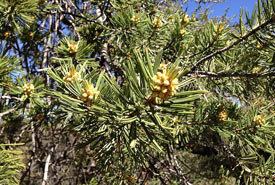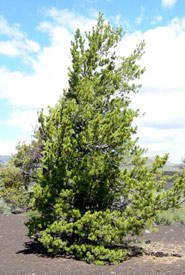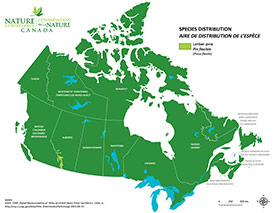
Limber pine pollen cones (Photo by Famartin/Wikimedia Commons)
Limber pine
Where is this species found?
Limber pine (also known as Rocky Mountain white pine) is a species of white pine, typically found in the montane and subalpine natural sub-regions of the Rocky Mountains. This species is widespread in the western United States, and in certain regions of western Mexico. Populations, however, can be sparse and in isolated pockets. It is at the northern limit of its range in British Columbia and Alberta.
Limber pines can live for more than 1,000 years under ideal ecological conditions, and don’t reach maturity until they are about 50 years old. A limber pine tree found at Crowsnest Pass is believed to be the oldest tree in Alberta, at an estimated 1,150 to 1,450 years old. Three limber pine trees found in the United States were also estimated to be between 1,000 to 2,000 years old. Both the common name and the Latin name (flexilis) refer to the flexible nature of the wood of this tree. Having flexible wood is an excellent adaptation for a tree that must deal with heavy snowpack and ice.
What does it look like and where does it grow?
Limber pine is a low- to mid-elevation species that often grows as a single tree or in widely spaced groups. It can grow in stands on its own, or at times with whitebark pine and other conifer species. The tree has silvery-grey bark when young that grows to be rough and darker in colour as the tree ages. Its needles are bluish-green and grow in tight bunches of five at the end of branches. Lower branches on older trees can be very long and drooping, with upturned tips. Limber pine is distinguishable from whitebark pine by its larger cones, which are yellowish-brown and cylindrical, measuring eight to 20 centimetres in length, with thickened scales toward the tip.

Limber pine (Photo by Wikimedia Commons)
Under ideal conditions, limber pines can grow 12 to 15 metres tall. Because they often grow in exposed areas such as the steep and rocky terrain of the Rocky Mountains, limber pine typically grows under five metres in height.
What is the species’ ecological role
As a keystone species found in low- to mid-elevation landscapes, limber pine is an important food source for many species. Its seed caches are a food source for small mammals, birds and bears. Specifically, the diet of Clark’s nutcrackers is made up mainly from the seeds of whitebark and limber pine.
Limber pine is an early establisher following fire and facilitates the establishment of other plants by providing protective shelter. Clark’s nutcrackers facilitated the establishment of limber pine by removing seeds from cones and dispersing them in caches across the landscape. While there are no descriptions of Indigenous use of limber pine this far north in the tree's range, Navajo, Chiricahua, and Mescalero people in the south have historically used the seeds medicinally and for food.
What is the species’ conservation status?
Limber pine is an endangered species and some subpopulations face extirpation (local extinction). Its Canadian range has been severely affected due to a number of threats, including mountain pine beetle and fire suppression, but white pine blister rust is the main cause of population decline.
In 2009, surveys conducted by Committee on the Status of Endangered Wildlife in Canada at some sites with limber pine in BC recorded close to 45 per cent of trees infected with blister rust and 35 per cent of trees dead. Based on these surveys, it is expected that an estimated two-thirds of mature individuals may be lost in the next century.
What is NCC doing to protect habitat for this species?
The Nature Conservancy of Canada (NCC) is involved in conservation work on several properties throughout southwestern Alberta along the eastern slopes of the Rocky Mountains, where stands of limber pine exist. This species is found on the exposed ridges of many projects in southwestern Alberta, including the Waldron Ranch, King Ranch and OH Ranch. Also, small populations can be found on the western slopes of the Rockies at NCC’s Columbia Lake Lot 48 and Luxor Linkage conservation areas in BC. In 2015, NCC, with assistance from local students, planted 500 limber pine on Columbia Lake Lot 48.
In addition to protecting habitat, the NCC’s Alberta Region is actively engaged in replanting efforts on several sites, in collaboration with Alberta Environment and Parks and the Whitebark Pine Ecosystem Recovery Foundation. In recent years, assessments have taken place throughout southwestern Alberta to identify areas that NCC could plant more limber pine seedlings, sites that may have trees resistant to blister rust, to highlight areas where limber pine once were but have been lost, and to add more information to the recovery efforts about locations of stands on private lands.






